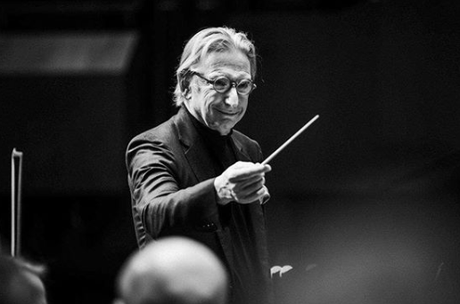by Paul J. Pelkonen

Michael Tilson Thomas leads the Vienna Philharmonic on tour in Europe.
Photo by Filip Waldmann from michaeltilsonthomas.com.
Imagine dear reader, that it's forty-odd years ago. You're reading this review not on a screen but in the pages of a local black and white newspaper, written by a modestly compensated professional staff critic. In this time, the touring virtuoso is a revered figure in the interpretation of so-called "classical" music. And the conductor, propped up by the determined efforts of a hugely profitable vinyl-based classical music industry, is still king. That's the heady era that was revisited in Tuesday's Carnegie Hall concert with Michael Tilson Thomas leading the Vienna Philharmonic in the first of their two performances together this week.
It is an inspired idea to bring together that esteemed Austrian orchestra and this American conductor, who is one of this year's resident artists. Mr. Thomas is one of the last figures to emerge from the glorious and long-gone golden age of classical music. Mentored by Leonard Bernstein, he rose to prominence on the tail end of the wave of the 20th century conductor system and for the past twenty-five years has led a comfortable and busy existence as head of the San Francisco Symphony. Today, "MTT" is revered as an educator, composer and conductor, a powerful figure in a system that is now very different from what it once was.
The first work on the program was Decoration Day by Charles Ives. The American iconoclast, who encapsulated the has long been an MTT specialty. It was prefaced with a short reading of the composer's own accompanying, explanatory text. ("What did he say?" asked the woman in front of me, loudly, when Mr. Thomas had finished.) In this work, the second movement of the larger New England Holiday Symphony, Ives painted a vivid portrait of the holiday that the U.S.A. now calls Memorial Day. The work veers between exuberance and grief through military melodies ("Taps") hymns, ("Adeste fidelis") and brilliant spatial effects, including upstage violins, innovative percussion and an offstage trumpet call that would make Mahler proud.
Despite Ives' compositional artistry and Mr. Thomas' enthusiasm for his work, this short ten-minute tone poem was played with polite, if puzzled refinement by the Viennese. The opening passages featured sonorous brass, a distant trumpet blowing "Taps" as if over the bloody battlefields of the Civil War. The wild parade section, where the orchestra slams into a march that sounds like Sousa on amphetamines became by the numbers party music, like the polkas and marches of Strauss that are such a specialty of this band. It was all over quickly, too quickly with a final fade-out that seemed to falter and die in its tracks.
Beethoven's Third Piano Concerto followed, with pianist Igor Levit making his first appearance on the big stage of Stern Auditorium. Mr. Thomas started slowly, carefully exposing the orchestral subjects and laying the groundwork for the entrance of the piano soloist. Mr. Levit's first chords were played with a hard staccato bite, harsh to the ear as if to maximize the forceful presence of Beethoven himself. A long, cadenza veered into the ether in soft cascades of pianissimo notes, lovingly played as orchestra and conductor waited. The Adagio was taken at an indulgent tempo, seeming to drift by as Mr. Levit played his solo passages. The trip-hammer finale was better, with soloist, orchestra and conductor seeming to find the music's groove at last. Mr. Levit added a gentle encore: the last two movements of Schumann's Kinderszenen, delicately played.
The second half featured Brahms' Second Symphony, a work this orchestra has long claimed ownership of. Here, Mr. Thomas seemed to be following the model of his mentor Leonard Bernstein, with a performance that replaced cause with affect. This was particularly noticeable in the leisurely, almost lazy pace of the first movement, as the note values stretched and the beautiful details of Brahms' thematic subjects unfurled with the pace of a heated summer day. The slow second movement was equally relaxed, with the orchestra seeming to stop and sniff each flower by a woodland path. A pretty approach, but one that wore on the ear as the music came round to its recapitulation.
The pace picked up in the Allegretto grazioso with its pretty, plucked strings. The ferocious trio section in the middle found the orchestra springing to vivid life, as if tired of lolling about and frantic for some sort of summer activity. Church-bell thirds rang out in the woodwinds and brass and the whole had a holiday feel. Curiously, though those bell-like intervals repeat in the fast finale, Mr. Thomas slowed them down as if to underline them and maximize their impact. A short encore followed, not the usual Vienna Philharmonic waltz but more Brahms: one of his raucous Hungarian dances. This bon-bon was snapped up by the eager audience, but the Carnegie Hall crowd seemed disappointed that no Strauss waltzes were played.
If you enjoyed this article, it's time to click over to Superconductor's Patreon page, and help support the cost of independent music journalism in New York City at the low cost of just $5/month.

